We know we should sun smart but what does that mean these days? What actually happens when the sun hits your skin? And is sun damage reversible?
One person dies every five hours from melanoma in Australia. One person is diagnosed with the skin cancer every half-hour. And two out of three Australians can expect to be diagnosed with skin cancer by the age of 70. Yet we remain remarkably unclear – and sometimes complacent – about what damage the sun does to our skin, and how to protect it.
“We’ve got a lot of work to do,” says Professor Richard Scolyer, co-medical director of Melanoma Institute Australia. “You can go to our beaches any day of the week and there’s thousands of people who are punishing their bodies, breeding their melanomas.”
Just over one in 10 of the 1001 people polled by Australian life insurer TAL in October believed they were “immune” from getting skin cancer, more than a third said they had never had a skin check and two-thirds could not correctly name the four key signs of skin cancer (see below).
There are many reasons for this but one, at least, is that Australia hasn’t had a national sun safety campaign in 13 years, since the memorable Slip, Slop Slap! from the '80s was reprised with an added Seek (shade) and Slide (on sunglasses). “Anyone under 13, they’ve never been exposed to a national skin cancer prevention campaign,” says Paige Preston, chair of Cancer Council Australia’s skin cancer committee. The result, she says, is confusion.
“People often just look at sunny days and temperature to determine their [sun-safety] behaviours,” she says. “Actually, it’s the UV [ultraviolet radiation] levels, these invisible parts of sunlight that we can’t see or feel [that matter], so there’s a bit of disconnect there.”
So, what is it about UV that we need to know? How can we prevent our skin cells getting “pulverised” with radiation? Is sun damage reversible? And don't we need to get some sun for vitamin D?
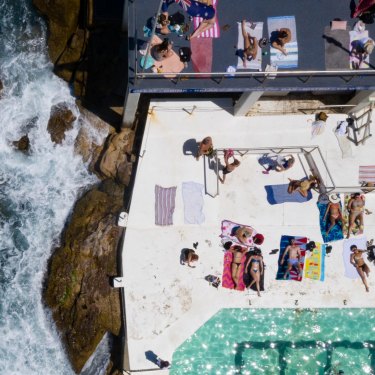
Swimmers at Icebergs in Bondi sunbake in December 2020.Credit:Janie Barrett
What does the sun really do to your skin?
The sun emits radiation that travels to Earth and is absorbed by the atmosphere – except for the radiation that is not. These rays are a source of both nourishment and damage. Proteins in our skin convert the radiation into vitamin D3, essential for bone and heart health (more on that later), but the rays also burn.
Two types of ultraviolet rays are the culprits (ultraviolet being beyond the visible colour spectrum at the violet end). Long-wave ultraviolet A light, or UVA, penetrates deep into skin, causing melasma (greyish-brown patches), wrinkles (as a result of damage to collagen fibres that provide elasticity) and leatheriness (from depleted collagen). It can also induce the kind of genetic damage that leads to skin cancer.
Shorter-wave ultraviolet B light, or UVB, penetrates the upper layer of our skin and is primarily responsible for sunburn and most skin cancers. (Solariums emit UVA and UVB radiation, which is why they are banned in all states and territories except for the Northern Territory.)
You can see that your skin cells are just smashed with UV damage, it’s like a car accident in your skin.
Both UVA rays and UVB rays, or photons, induce tanning, too, by triggering melanocytes – cells that produce melanin, a brown pigment. This is the skin's attempt to block radiation from penetrating your skin and causing further damage. But there is no such thing as a "healthy tan" because most tanning is believed to be part of an overall stress response to damaged DNA, primarily caused by UVB rays.
“When you go into the sun, if your skin is exposed – no sunscreen or anything over it – your skin is getting smashed by UVB photons, high-energy photons,” says Professor David Whiteman, deputy director of QIMR Berghofer Medical Research Institute in Brisbane.
For fair-skinned people, who have almost no protective melanin, says Whiteman: “[When] you go outside, your skin gets pulverised … Under the microscope, you can see that your skin cells are just smashed with UV damage, it’s like a car accident in your skin.”
We also have enzymes in our bodies that work non-stop to repair the damage that UV photons do to our cells, and to replace damaged bits of DNA.
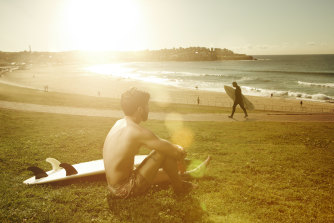
By the time you have sunburn, your body is sending out danger signals. Credit:Getty Images
How does the sun cause skin cancer though?
When sunlight radiation hits your skin, UVB rays (primarily) can damage a cell. When an unrepaired cell divides, the damaged DNA is passed on to daughter cells. Over a person's lifetime, the cells divide many times, passing the mutation to more and more daughter cells. The key issue is where the damage occurs in the genetic code. Each cell in our body contains 30,000 genes, each with a different function.
“If [the UVB light] hits a gene that critically is involved in that process of cell division then the cell can just keep dividing repeatedly, that’s how cancer starts,” says Whiteman. “Once the cell loses the ability to switch itself off and just behave, once it loses that regulation, it’s just open slather. That’s what cancer is.
“By the time you’ve got a sunburn … your body is sending out, basically, danger systems, saying, ‘I’m overwhelmed, I’ve got dead cells all over the place’,” says Whiteman.
Sunburn, a radiation burn, might be the leading cause in most cases of skin cancer but it is just one of several mechanisms through which cells acquire damage that starts the cancer ball rolling. Repeated, incidental sun exposure is another significant driver.
The more times you go out in the sun, and the more times you get damaged, the higher the probability that you’re going to hit a bad gene …
“What is known is that the more times you go out in the sun, and the more times you get damaged, the higher the probability that you’re going to hit a bad gene [that controls cell division],” says Whiteman. He says Australia’s high incidence of fair-skinned people, the minimal amount of protective clothing that many of us wear and high temperatures mean “the odds are stacked against us [that] eventually, somewhere on your body, you’ll get a skin cancer”.
This partly accounts for why at least two in three Australians will be diagnosed with skin cancer before 70, according to Cancer Council Australia. By comparison, roughly one in five Americans reportedly develop skin cancer in their lifetime.
Melanoma is not the only kind; there is also basal cell carcinoma (BCC) and squamous cell carcinoma (SCC). BCC and SCC, which account for around 98 per cent of skin cancers in Australia, start in the top layer of the skin (the epidermis) and rarely spread (metastasise) to other parts of the body. Both types of cancers can usually be surgically removed.
They do have their risks, though. Beyond a small risk of metastasising, non-melanoma skin cancers – even a BCC – can run deep under the skin, requiring the removal of a large field of tissue that can disfigure a person. After an operation to remove a BCC from her nose, former US Vogue model Zacki Murphy wrote of a photo taken of her: “My friend titled the photo, ‘Anne Boleyn after Beheading’.”
Melanoma, which begins in the pigment-making, or melanocyte, cells in the skin, is overwhelmingly the most dangerous skin cancer. If not caught early, it is far more likely to spread rapidly. As Science Daily once put it, “Unlike other cancers, melanoma is born with its metastatic engines fully revved.”
This explains why, while there are reportedly nearly 770,000 new cases of BCC and SCC in Australia each year and about 12,000 cases of melanoma, rates of melanoma mortality are comparatively high. While 678 people died of non-melanoma skin cancer in 2019, 1415 people died of melanoma, a Cancer Council Australia report shows.
While noses are a common locale for skin cancer, it can happen anywhere on your body.
While noses are a common locale for skin cancer, it can happen anywhere on your body including, albeit rarely, genitals, inside the eye, mouth, under fingernails and toenails, on the palms of hands and on the soles of feet.
It is possible but rare to get skin cancer that is unrelated to exposure from the sun. Most notably, some people have a variation of the MC1R gene (a key regulator of pigmentation that leads people to have red hair, freckles and fair skin), which gives them a higher risk of developing skin cancer as a result of having faulty DNA repair mechanisms and insufficient melanin.
Is having dark skin a protective factor?
“For people with darkly pigmented skin, their lifetime risk of skin cancer is very, very low; their need for protective steps is lower,” says Whiteman.
But – and this is crucial – it is far from zero.
Melanoma may be more than 20 times more common in white people than African-Americans, according to the American Cancer Society, but the fate of an individual cannot be predicted by a statistically lower probability of getting skin cancer.
“Remember, probability is probability based over a population, not over an individual, so it says nothing about you or I as individuals,” says Scientia Professor Justin Gooding of the University of NSW, who has pioneered a new, wearable, UV sensor. “You may have other genetic factors that mean that [the low probability of skin cancer] doesn’t apply to you. You might be one of the ones that are more susceptible [to skin cancer] or less.”
Scolyer, who examines hard-to-diagnose skin biopsies from around the world as a diagnostic oncologist at Royal Prince Alfred Hospital in Sydney, adds this: “Many people get melanoma who’ve got a low risk … We know even people with extremely dark skin get melanoma.”
Jamaican reggae legend Bob Marley died of melanoma when he was 36. (It began as a dark spot that appeared under his toenail and spread to other parts of his body.)
This is why the Australian guidelines about sunscreen use pertain to all Australians, regardless of their skin colour.
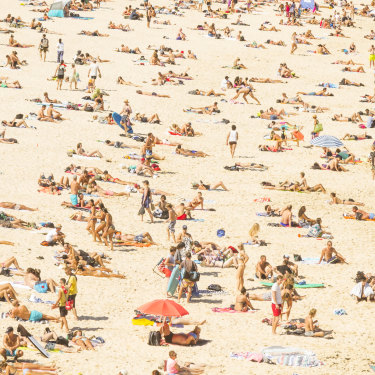
Sunbathing at Bondi. The five-year survival rate for patients with advanced melanoma has risen to 50 per cent.Credit:Getty Images
Is sun damage reversible?
Actinic keratosis, commonly known as a sun spot, is a type of skin damage that increases the risk of skin cancer – it is a precursor to SCC. And, says Scolyer, regular use of sunscreen can make many of these sun spots “regress” and go away.
Generally speaking, though, sun damage is permanent. Cosmetic surgeons and dermatologists can help reduce visible damage with treatments such as retinol cream and microdermabrasion for wrinkles and sun spots.
Melanoma can often be cured – by being completely removed – particularly if it's detected early and if it is less than one millimetre deep. And recent advances in immunotherapy and targeted therapy cancer drugs are enabling people to survive melanoma for longer.
“A decade ago, if you had melanoma that had spread to your brain, most people would be dead in six weeks,” says Scolyer. “Now most people who have had melanoma spread to their brain are alive a year later.”
The five-year survival rate for patients with advanced melanoma has risen too: “Ten years ago, it was 5 per cent. Now it’s 50 per cent.”
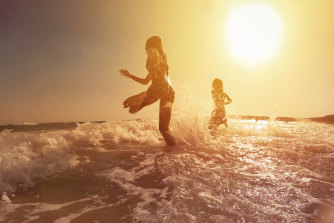
You should get enough vitamin D from incidental sun exposure while wearing sunscreen.Credit:Getty Images
What does the sun have to do with vitamins?
Ninety per cent of the vitamin D in our bodies comes from sunlight on our skin; 10 per cent from dietary nutrients such as dairy products, eggs and fish. UVB, the same wavelengths that cause sunburn, make vitamin D3 (the active form of vitamin D) in our bodies when they interact with a skin protein called 7-DHC.
Vitamin D plays a crucial role in our health: it helps make sure we have enough calcium in our bones. Calcium also plays an important role in heart and brain function.
Although an imprecise science, the study of vitamin D suggests that people from some cultures may require less vitamin D than others.
“African-Americans may not need as much vitamin D as their white counterparts to make sure they have healthy bones,” says Professor Rachel Neale, head of the cancer aetiology and prevention research group at QIMR Berghofer Medical Research Institute. “That evidence is emerging but not completely solid. We don’t yet know whether everybody needs exactly the same amount.”
The bottom line? Most Australians get enough vitamin D from incidental sun exposure even while wearing sunscreen.
At the same time, Australia lacks hard-and-fast guidelines as to how much vitamin D people need. Neale is developing a project in order to create some.
Until then, the recommendation in Australia – a conservative one, says Neale – is that we have 50 nanomoles per litre in our blood. By this estimate, she says, 23 per cent of Australians are vitamin D-deficient. By British standards – which recommend only 25 nanomoles per litre – only 6 per cent of Australians are deficient. (Neale says that “25 to 30” nanomoles are “probably enough”.)
The bottom line? Most Australians get enough vitamin D from incidental sun exposure even while wearing sunscreen.
“Vitamin D is one part to the story," says Neale. "Actually, the best thing you can do to look after your bones is exercise. Weight-bearing exercise is equally, if not more, important than vitamin D.”
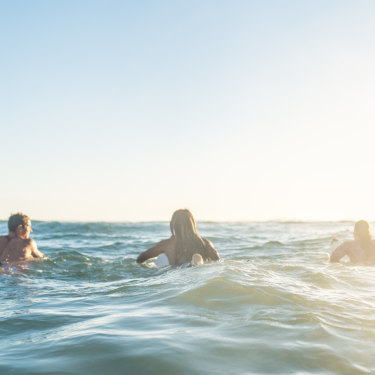
The UV scale is the factor to watch for.Credit:Getty Images
What can you do to protect your body from the sun?
Sunscreen guidelines announced in 2019 advise applying sunscreen every morning when the UV level is three or higher. The UV scale runs from zero to 11+. To monitor UV levels where you are, check the Bureau of Meteorology’s website, bom.gov.au, or download the bureau’s SunSmart app.
"UV levels are the only indicator that is accurate for when sun protection is needed," says Paige Preston, of Cancer Council Australia, adding that, all too often, people incorrectly determine their sunscreen habits based on what they see and feel – cloud levels, how hot it is. UV rays are invisible and are often high even when it is cloudy, grey and only moderately warm. "A combination of the cloudy, overcast days and the temperature lulls people into a false sense of security," says Preston.
Avoid sun exposure in the middle of the day, from 10am to 3pm, when UV levels are at their highest.
Reapply sunscreen after you become wet and otherwise every two or three hours, regardless of where you are, in order to cover you for incidental sun exposure.
A word on sunglasses, too. Whiteman says our eyes can suffer sun damage from UV rays. In fact, BCCs can flourish on the eyelids, he says, particularly in the inner corners. Our eyes' lenses can be damaged by sunlight and some melanomas can arise in the retina (although rare, it is believed that sunlight is a likely contributor). People should buy Australian sunglasses, adds Whiteman, as they must meet strict Australian guidelines, as opposed to sunglasses sold at markets, which could be sourced from anywhere.
According to the Australian Radiation Protection and Nuclear Safety Agency, sunglasses that comply with the Australian sunglass standard – labelled as "sunglasses" or "special purpose sunglasses" rather than as "fashion spectacles" – and with the Australian standard AS/NZS 1067 provide eyes with "substantial protection" against the sun and are recommended for both children and adults, "particularly the wrap-around type that give … protection from the sides".
Book in for regular skin checks and see your doctor if you notice any changes in your skin. These include four signs of skin cancer: crusty, non-healing sores, small bumps that are red, pale or pearly in colour, new spots and freckles or moles that have changed in colour, thickness or shape. For a full list visit cancer.org.au, and to assess your risk of melanoma, visit www.melanomarisk.org.au.
For skin cancer, surveillance is right in our face. It’s not, like, inside your body and we can’t see it.
And consider – with a caveat – using new sun safety technologies, such as stickers that change colour when exposed to the sun, and UV sensors embedded in smart watches and smart phones, which indicate when you have gone over your safe limit of UV radiation. There are already some on the market. And there are many, developed by Australian universities and awaiting commercial partnership, such as a Band-Aid-like UV sticker (created by scientists at the University of NSW) and a UV sensor (by scientists at Macquarie University) that can be incorporated into an existing smart watch, Fitbit or sunglasses, and that will use Bluetooth to alert the user when they’ve gone over their UV radiation limit.
The caveat? These technologies won’t protect your skin by themselves.
“It’s one thing to have a sensor and watch that works and gives the right information; then we have to understand, does that make people stay out [in the sun] longer? Shorter?” says Whiteman.
What frustrates cancer specialists is how low skin cancer figures could be – and how many people could avoid disfigurement – if only we followed their advice.
“There’s no limit, [where] you’re not at risk of getting melanoma,” says Scolyer. “If you see something on your skin, get it looked at, please, as soon as you see it. Because if you get it early, you’ll be cured. For skin cancer, surveillance is right in our face. It’s not, like, inside your body and we can’t see it. We have the opportunity to look in the mirror each day [and] use that benefit to pick them up early.”
Samantha Selinger-Morris is a lifestyle writer for the Sydney Morning Herald and The Age.
Most Viewed in Lifestyle
https://news.google.com/__i/rss/rd/articles/CBMic2h0dHBzOi8vd3d3LnNtaC5jb20uYXUvbGlmZXN0eWxlL2hlYWx0aC1hbmQtd2VsbG5lc3Mvd2hhdC1leGFjdGx5LWRvZXMtdGhlLXN1bi1kby10by15b3VyLXNraW4tMjAyMDEyMTQtcDU2bjdxLmh0bWzSAXNodHRwczovL2FtcC5zbWguY29tLmF1L2xpZmVzdHlsZS9oZWFsdGgtYW5kLXdlbGxuZXNzL3doYXQtZXhhY3RseS1kb2VzLXRoZS1zdW4tZG8tdG8teW91ci1za2luLTIwMjAxMjE0LXA1Nm43cS5odG1s?oc=5
2021-01-04 01:31:00Z
CAIiEMuKyM8joU1ysndIxA0VOBwqGQgEKhAIACoHCAowxqmICzDg_IYDMIbgmwY
Bagikan Berita Ini














0 Response to "What exactly does the sun do to your skin? - Sydney Morning Herald"
Post a Comment